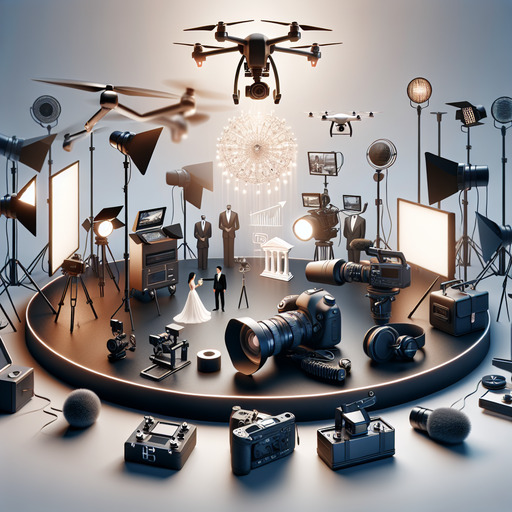
-
Table of Contents
Ready to elevate your video production game? Discover expert tips on choosing the right video production equipment! Learn more here.
Introduction
Choosing the right video production equipment is crucial for creating high-quality content that meets your specific needs and goals. Whether you’re a beginner or a seasoned professional, understanding the various types of equipment available and their respective functions can significantly impact the outcome of your projects. This guide will walk you through the essential factors to consider, including camera types, audio equipment, lighting, stabilization tools, and editing software, to help you make informed decisions and invest wisely in your video production journey.
How to Choose the Right Video Production Equipment for Professional Videography Services: Tips for Wedding, Real Estate, and Cinematic Videography, Including Drone Videography and Video Marketing Strategies
Choosing the right video production equipment is crucial for delivering high-quality professional videography services, whether you’re capturing the magic of a wedding, showcasing real estate properties, or creating cinematic masterpieces. The right tools can make a significant difference in the final product, and understanding what to look for can help you make informed decisions. This article will guide you through the essential considerations for selecting video production equipment, including tips for drone videography and video marketing strategies.
First and foremost, the type of camera you choose is fundamental. For wedding videography, a camera with excellent low-light performance is essential, as many ceremonies and receptions take place in dimly lit environments. Full-frame DSLRs or mirrorless cameras are often preferred for their superior image quality and versatility. On the other hand, real estate videography benefits from cameras with wide-angle lenses to capture the full scope of properties. In cinematic videography, the emphasis is on cameras that offer high dynamic range and 4K resolution to achieve that filmic look.
In addition to the camera, the choice of lenses plays a pivotal role. Prime lenses, known for their sharpness and wide apertures, are ideal for wedding and cinematic videography, allowing for beautiful bokeh and excellent low-light performance. For real estate, zoom lenses with a range of focal lengths can provide flexibility in capturing both wide shots and detailed close-ups. Transitioning to drone videography, the built-in cameras on drones like the DJI Phantom or Mavic series are typically sufficient, but ensure they offer at least 4K resolution for professional results.
Stabilization is another critical factor. Gimbals and tripods are indispensable for maintaining steady shots. For weddings, a handheld gimbal can help you move smoothly through the event, capturing dynamic moments without the shakiness. In real estate, a tripod ensures stable, professional-looking shots of interiors and exteriors. For cinematic videography, a combination of gimbals, tripods, and even sliders can add a variety of smooth, controlled movements to your footage.
Lighting equipment cannot be overlooked. For weddings, portable LED lights can be a lifesaver in poorly lit venues. Real estate videography often requires softbox lights to evenly illuminate rooms, making them appear more inviting. In cinematic videography, a comprehensive lighting kit, including key lights, fill lights, and backlights, is essential for creating depth and mood in your scenes.
Audio quality is equally important. For weddings, lavalier microphones are ideal for capturing vows and speeches clearly, while shotgun microphones can pick up ambient sounds. In real estate, a good shotgun microphone can help capture the natural acoustics of a property. For cinematic projects, investing in high-quality boom microphones and external audio recorders can significantly enhance the overall production value.
Lastly, consider your post-production needs. Powerful editing software like Adobe Premiere Pro or Final Cut Pro is essential for all types of videography. For drone videography, software that supports 4K editing and color grading is crucial to make the most of your aerial footage. Additionally, understanding video marketing strategies can help you tailor your content to different platforms, ensuring it reaches your target audience effectively.
In conclusion, selecting the right video production equipment involves careful consideration of your specific needs and the type of videography you specialize in. By investing in high-quality cameras, lenses, stabilization tools, lighting, and audio equipment, and by leveraging effective video marketing strategies, you can elevate your professional videography services to new heights.
Q&A
1. **What factors should I consider when choosing video production equipment?**
– **Budget:** Determine how much you are willing to spend.
– **Purpose:** Identify the type of videos you plan to produce (e.g., vlogs, short films, corporate videos).
– **Camera:** Choose a camera that suits your needs, considering factors like resolution, frame rate, and sensor size.
– **Audio:** Invest in quality microphones and audio recording equipment.
– **Lighting:** Ensure you have proper lighting equipment to enhance video quality.
– **Stabilization:** Consider tripods, gimbals, or stabilizers for smooth footage.
– **Editing Software:** Select software that matches your skill level and project requirements.
– **Portability:** If you need to shoot on location, consider the portability of your equipment.
– **Future-Proofing:** Think about your future needs and whether the equipment can scale with your projects.